The Artist Known As…
Tuesday 17 May 2016. To Vout-o-Reenee’s to take a photo. It’s for my entry to a Birkbeck competition, which is asking for photos on the theme of ‘London Relocated’. An idea occurred to me, so I thought I’d give it a go. I thought about the way the Vout’s club is effectively the spirit of bohemian Soho relocated, in this case a few miles east in Tower Hill. Tonight I get Sophie Parkin to pose at the bar for my hopeful little image, alongside her book on the deceased Soho club, the Colony Room. I also get my own membership card of the Colony into the shot, visible on the counter of the Vout’s bar.
Sophie tells me about the charity Little Paper Slipper, which is having a major event at Vout’s in June. This is a charity that organises therapeutic art workshops, for women affected by domestic abuse. The end result is a series of exhibitions of the eponymous slippers, each one personalised by the woman who made it. There’s about 150 of them now.  The event at Vout’s is going to be a fundraising auction, featuring shoes specially made for the charity by a group of artists, including Gavin Turk, Molly Parkin, and John Claridge.
I’m happy to help publicise the event. There’s further details at Facebook here.
There’s some fascinating photos of the workshop slippers at the charity website:Â www.littlepaperslipper.com/slippers.html
***
Wednesday 18 May 2016. Evening: my debut as a conceptual artist. I am given a sticker for my lapel which says: ‘Dickon Edwards – Artist’. So it must be true.
The venue is Birkbeck’s School of Arts, on the east side of Gordon Square, once home to Virginia Woolf. This week is Birkbeck’s annual Arts Week, a series of free talks and events that are open to the public. Over the cast iron railings at the main entrance are the words ‘ARTS WEEK’ rendered as huge, colourful knitted letters. I discover that this display is not, as I’d hoped, the product of an MA course in Comparative Knitting, but the handiwork of two knitting-loving administrators, Claire Adams and Catherine Catrix.
Given the building’s history, I wonder what would have happened if those fateful railings in Mrs Dalloway had been similarly wool-clad. Septimus Smith might have ended the novel in better shape. Another thought is The Muppets’ Mrs Dalloway. Starring Miss Piggy as Clarissa: ‘Moi will buy the flowers myself!’
Inside, Room 112 hosts The Contemporary: An Exhibition. This is a ‘pop-up’ show by four students of the MA Contemporary Literature and Culture course, and addresses the question: what is ‘the contemporary’? The contributors are Kathryn Butterworth (in partnership with James Watkinson), Jassey Parmar, Dylan Williams, and myself. The event is the idea of the main course tutor, Grace Halden, who thought it would be good to have the MA represented during Arts Week.
Kathryn and James’s display is a multimedia look at technology and literature: there’s large boards covered in texts, computer diagrams, a model of DNA code, and laptops playing audio and video content. Jassey’s exhibit is a series of photographs of London shop fronts, which blend different cultures and brands in unexpected ways. Twice during the evening, Dylan performs a selection of his own poetry. And I’ve contributed a social media installation titled Is It Just Me?
I had the idea some years ago. It was one of those ideas that don’t go away. So I thought I’d either put it in a story, or just keep it in reserve, in case someone asked me to contribute to an exhibition.
So one day someone did, and here I am. A debut artist.
At the event, I give out an A4 handout to explain my thinking behind the installation. I’ve uploaded it here as a PDF:
Is it Just Me – installation handout
I also leave out a sheet of my handwritten notes for the project. I like the juxtaposition of the shifting internet content on the screen, with the fixed artifact of my handwriting on paper. Private traces of the body, versus public traces of the mind.
The event turns out to be decently attended, with tutors stopping by to say kind things. It all seems to go okay, and there’s no technical hitches, thanks to the efficiency of Birkbeck’s staff. How wonderful it is to have an idea which involves cables and equipment, but not have to worry about the cables and equipment oneself.
Here’s some photos from the course’s Facebook page (most of them taken by Lee Smith, used with permission):
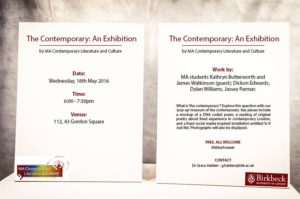
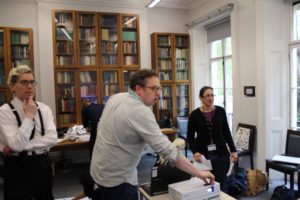
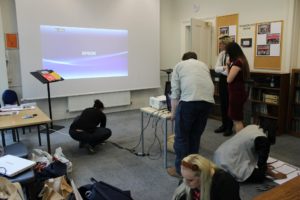
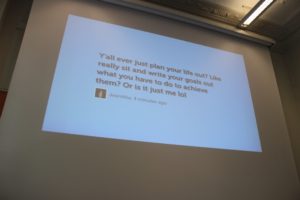
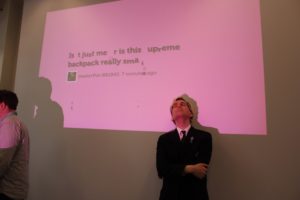
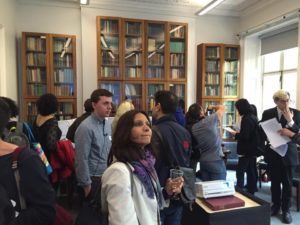
And here’s a link to the Facebook page for the MA in Contemporary Lit and Culture
***
Thursday 19th May 2016. Thinking more about Prince, and about camp uses of the colour purple, I’m reminded of this anecdote from Gary McMahon’s Camp in Literature (2006, p. 144):
‘Brigid Brophy notes that [Ronald] Firbank often wrote his tales in purple ink on blue postcards, surface and colour being everything to camp. Brophy reveals that she too wrote her critical biography of the man [Prancing Novelist, 1973] in purple ink. My working copy of Brophy’s book is on loan from Manchester University’s library. At this purple confession on page 173, a university student […] has written this response in the margin:
“Are you [Brophy] really as besotted as this? If so, we don’t want to know. At least maintain a pretence at objectivity, please.”
McMahon remarks that this student represents a certain academic sensibility ‘that is always going to be exasperated and offended by camp’.
Returning to Prince, I think of a friend’s anecdote along the same lines. When this friend was growing up in the 80s, some blokish gentleman known to them – a friend or possibly a dad – took one look at a Prince record sleeve and remarked, quite out of the blue, ‘I don’t care what he sounds like. I’m not listening to anyone who dresses like that.’
***
Friday 20th May 2016. I receive the grade for my second essay on the MA. Despite my struggles with it, I am very pleased indeed to get a 76 (a mark over 70 is a Distinction, the MA equivalent of a First). The first essay got a 73. It’s a nice boost to my confidence when I needed it most, wracked as I was with Difficult Second Term Syndrome.
For the rest of the summer, I have to get on with postgraduate-y things under my own steam, such as attending open lectures and pursuing my own research. But as far as the big assessments go, the pressure is off until the autumn.
Tags:
art,
birkbeck,
birkbeck arts week,
brigid brophy,
colony room,
little paper slipper,
Prince,
ronald firbank,
sophie parkin,
vout-o-reenee's
A Bohemian Birthday
Tuesday 1st September 2015
To the ICA for a Carol Morley event. This comprises a launch of her new autobiographical novel, 7 Miles Out, along with a rare screening of her film from 2000, The Alcohol Years. I saw it on Channel 4 around that time (I think), and have looked out for Ms M’s name ever since. Her latest, The Falling, remains my favourite film of 2015. As is often the case, rewatching The Alcohol Years with an audience, and on a big screen, enhances the whole experience. The funny bits become much more funny, the shocking bits much more shocking.
At the ICA I bump into Debbie Smith and Atalanta Kernick, and spend the rest of the night with them, drinking. I also meet Ms Morley herself. When the ICA kicks us out at 11pm, we all head off in taxis to Sophie Parkin’s members’ bar, Vout-O-Reenee’s, in Tower Hill. It’s my suggestion, but to my delight it is seconded by one of Ms M’s friends, who produces a Vout’s calling card. So I end up having a perfect evening, drinking with lots of different people I admire, all brought together in a place where people know me, and where the spirit of the Colony Room is kept alive. Despite the inevitable gaps in my memory of this boozy night, what I do remember is being happy.
* * *
Thursday 3rd September 2015.
My 44th birthday. ‘Hope you gets lots of presents and cards’ says an automated email newsletter, for a product I can’t remember buying. Lots of cards and presents? Well, I do get some, from my closer relatives and from a couple of friends. But it’s Facebook messages that I’m more likely to receive in an amount that can be described as ‘lots’. The best part of a hundred, this time. Despite such messages requiring a few seconds’ keystrokes, not everyone on FB does it for every one of their contacts (myself included). So it’s still a gesture of niceness, of being thought of, and I’m touched.
I spend much of the day with my usual solitary exploration of new stuff. A birthday is a celebration of a still-working body, so one must mark it by giving still-working eyes new sights, and still-working legs new places.
This year, I finally tick off St Paul’s Cathedral. A Londoner who’s never gone inside St Paul’s is like a New Yorker who’s never been inside the Statue of Liberty: there’s plenty of them, but they don’t quite know why. For years they put off the visiting of a local treasure, feeling its fame with tourists somehow makes it harder to go. It’s like that definition of a literary classic: a book which everyone assumes you’ve read.
St Paul’s hasn’t got Westminster Abbey’s monopoly on dead kings and queens and poets, but it is much better looking. Commissioned from Wren as the first big Protestant cathedral since the split from Catholicism, it is nevertheless as giddily Baroque as Anglicanism gets. Soaring, elegant arches, golden circular mosaics and domes within domes. I love how the main blue dome is actually on top of a second dome, to get the building as tall as possible. I climb the umpteen steps to the Whispering Gallery, which frightens me with its narrow walkway, so high above the floor. Oddly, I find the external Stone Gallery much more calming, even though it’s higher up and exposed to the elements. The walkway is wide, and well-protected, and the view is unusual for being that rare thing: a London skyline without St Paul’s.
In the crypt are the big military graves and memorials: Nelson, Wellington, Churchill. But there’s plenty of artists and musicians too: the tombs of Parry and Sullivan, and a cenotaph to Blake. I’m in the crypt when I look down and realise I am walking over the bones of JMW Turner, lying next to Reynolds, Millais, and Holman Hunt.
* * *
Then to a beach in Vauxhall, to see some brand new art. Most of today’s newspapers have the same shocking photograph on the cover: the body of a Syrian migrant boy, washed up onto a Turkish beach. There have been calls for humanity and compassion across the board, even from the newspapers that tend to rail against migrants, like the Mail. Some are saying this might mark a tipping-point, towards an era where human life is finally valued above economic and political concerns. Well, that would be nice.
I wonder how much the setting of the beach contributes to the power of the image. The beach has always been a vivid symbol of change, of humanity stepping forward – or backward. On Vauxhall Beach today (on the south bank, a little downriver of Vauxhall Bridge) is a piece of public art by Jason deCaires Taylor. Titled ‘The Rising Tide’, it’s an ingenious warning about climate change, which uses the natural tide of the Thames to make its point. The artwork comprises four life-size sculptures of apocalyptic horse riders, two men and two children. The horses’ heads are surreally replaced with the lozenge-shaped metal heads of oil pumps. The mens’ horses are ‘grazing’ from the sand (presumably helping themselves to oil), while the children’s horses are yet to feed. All four figures have their eyes closed. When the tide is high, the sculptures are fully submerged. The artwork is only meant to be here for a month, but judging by the crowds around the sculptures today (at low tide, that is), it has all the makings of a public art hit.
* * *
After that, to a third new sight: the Heights Bar in Langham Place, next to BBC Broadcasting House. I read about the venue in the book Mindful London, which recommends it for moments of quiet contemplation of the city. It’s airy, friendly, and has lots of space, with large soundproofed windows looking out 15 storeys above Oxford Street. A certain secret knowledge is required: you have to walk into the lobby of the Saint George’s Hotel, then take the lift. Unlike many rooftop bars and restaurants in the city, Heights is reasonably affordable (even for me), and needs no advance booking. Not even if you’re on your own.
By this point, it’s early evening. After a day of solitary contemplation on turning 44, I suddenly feel the need for birthday company. Unfortunately I have made no plans whatsoever. It seems unfair to expect friends to suddenly drop what they’re doing and join me, birthday or no – that would be the friendship equivalent of zero hours contracts. But I try anyway, texting a few friends in case they’re available. Charley S happens to work at the BBC publicity department next door. Though she’s visibly drained by a busy day at work (it’s New Doctor Who Day today), she kindly joins me for a while, before heading off for an early night.
Then I decide to get on a tube to Tower Hill, and impose myself on Vout-O-Reenee’s once again. I enter to a rendition of ‘Happy Birthday’ by Ms Parkin and the regulars. Later on, Debbie Smith turns up and buys me champagne, this time accompanied by Beth, the singer from her current band Blindness. There’s another surprise when Ms Parkin suddenly presents me with a freshly-baked chocolate cake, hot from the Vout’s oven, and complete with a candle. I think it’s the first time I’ve had to blow out candles on a cake since I was about 9.
* * *
On waiting for a Night Bus home, I am laughed at by a group of young students. They are chatting as they approach, then suddenly pause as they pass, then burst into spluttering mockery as they walk on.
Today I’m wearing a birthday present, in fact: a brand new made-to-measure linen suit, being a gift from my mother. The tailor I saw at A Suit That Fits, in Glasshouse Street, had convinced me to have the jacket tapered around the chest, rather than my usual preference of a loose (and indeed louche) bagginess. While it’s not quite Zoot Suit territory, this extra definition in the cut must enhance my ability to stand out, for better or worse. On the Tube earlier, I had a couple of ‘nice suit mate’ comments. I suppose these catcalls may well be sarcastic, but at least they weren’t accompanied with group laughter. That’s the aspect that never feels nice, especially when walking alone.
So I struggle with twisting this ending to an otherwise pleasing day into some sort of positive conclusion to turning 44. I could look at it as confirmation of My Role in Society. Someone has to be Visibly Weird, so all the Confidently Normal people can feel good about themselves. (You’re welcome, society!)
But no, that’s an angry reaction. It’s better to just view all mockery as a compliment to one’s individuality. Indeed, much of the attention is because I am simply out in public by myself, and they are nearly always in groups. If I can receive the same sort of reactions that I’ve had since being a teenager, I have demonstrably still ‘got it’, whatever that may be. It’s proof that I exist, and it’s nice to exist. In other words, happy birthday.
Tags:
a suit that fits,
carol morley,
debbie smith,
heights bar,
ICA,
jason decaires taylor,
my birthday,
sophie parkin,
st paul's cathedral,
vout-o-reenee's
Not The Conga Kind
Saturday 6th June 2015.
Still in a post-degree limbo, I find myself recalling my first encounter with the concept of academic writing. It was the 1983 book Doctor Who: The Unfolding Text, the first such academic text on the TV series. No shortage of them now. One of my BA seminars on cultural nostalgia included the observation that the 50th anniversary episode, The Day of the Doctor, tapped directly into the programme’s association with generational memories. Specifically, the idea that people’s favourite Doctor was often the one they grew up with.
In 1983, I was a big enough fan to investigate any book on the show, and so picked up The Unfolding Text in a bookshop. The cover seemed fan-friendly enough: a photo of the current Doctor – Peter Davison – in front of the TARDIS. But the text inside was utterly baffling. English phrases, yet used in a way that I just couldn’t understand: ‘semiotics’ this, and ‘signified’ that. To an eleven-year-old boy, academia seemed rather, well, alien.
Today, I like to think I could finally go back to that book and understand it. Or at least, some of it.
* * *
To Smollensky’s, a restaurant in Canary Wharf, for the wedding reception of my cousin Jonathan. Mum and Tom are there, along with cousins I’ve not seen for years, like Caroline and Beth. Caroline says she saw me on that Imagine programme on blogging – and that was ten years ago. Time leaks away.
Wedding DJ music in 2015: the Jackson Five, One Direction, Beyonce, Franz Ferdinand.
At one point a conga line dances through the venue, and sweeps up most people in the room. All except the Peroxide Contingent: Â myself, Tom, and Tom’s partner Ms C, who has bleached white hair, shaved at the sides. For one horrifying moment, I think I’m going to be dragged into the conga line. But a code of respectful glances passes between us. Family though we all are, everyone is different, some more than others, and that’s okay.
Whatever I am, I know I am not the conga kind.
* * *
Sunday 7th June 2015.
To a sunny Regent’s Park for Martin W’s annual birthday picnic. Martin still sends out paper invites in the post, double-sided. This year’s invite star is Edith Sitwell, her photo tinted like a Smiths sleeve.
Also present: a few Birkbeck tutors such as Joe Brooker and Caroline Edwards (no relation, but the second C.E. in one weekend), Adrian Lobb, and Lauren Laverne, whom I last saw (I think) at the last ever Kenickie concert. It seems redundant to ask Ms LL what she’s been up to since then, but I’m very pleased to see her again. Birkbeck now, Kenickie then: worlds colliding, time collapsing.
* * *
Monday 8th June 2015.
Evening: to the beautiful Brunei Gallery in Bloomsbury, for a Birkbeck panel event about jobs in the arts sector, followed by a vegetarian dinner at the Coach and Horses, courtesy of Hester R.
At the event, one man from the BBC says, ‘Golden rule for getting work: close your Facebook account at once. People check.’ He doesn’t go into detail, but I presume he means just closing down the security settings. From my experience, FB can be helpful for networking and asking for advice, as long as it’s confined to friends only.
This is a very modern dilemma though: Googling a prospective employee may give quite an unfair impression of the way a person is now, as opposed to the way they used to be. One of the new influx of MPs at the recent election was a woman young enough to have grown up with Twitter. The media and Have I Got News For You soon found a series of embarrassing tweets she’d made in her teenage years, still there, still online. Not career-destroying, but it made me think of the way the internet is like Autolycus in The Winter’s Tale: a snapper-up of unconsidered trifles.
If I were an employer, the fact that a candidate had recently closed down their social media account would be more worrying than if they hadn’t.
* * *
Funny how things get uninvented. Today I have to explain to a younger person on Twitter what an internet café was. I used to frequent them in London, before the explosion in wifi and broadband, circa 2002.
I remember one man shouting in through the door of an internet cafe: ‘Why don’t you all just make a phone call?’
The phone got its own back in the end.
* * *
Tuesday 9th June 2015.
An excellent evening spent in the ornate Cafe Royal on Regent Street, attending Ian Kelly’s talk on Beau Brummell. I cheekily turn up unannounced, hoping Suzette Field will let me in – it’s one of her Curious Invitation events - and am grateful that she does. I chat with Joanne Kernan, Laura Bridgeman, Debbie Smith and their dapper pals from the besuited butch female troupe, the Drakes. A suit-lover’s Utopia, frankly.
Learned tonight: the term ‘toff’ is thought to come from ‘toffee-nosed’, after the brown stains on the noses of Regency snuff-takers. And there are references to Beau Brummell in the lyrics of at least two musicals: Annie and Gypsy.
Mr Kelly’s scoop for his 2005 biography is that he discovered Brummell died of syphilis. No one had checked the medical records until then.
* * *
Wednesday 10th June 2015.
To St Thomas’s Hospital on the south side of Westminster Bridge, visiting Heather M after an operation. Her bed has an eighth-floor riverside view, directly opposite Big Ben. It is the view that so many London-set films insist can be seen from any window. ‘Scene: London’.
* * *
Thursday 11th June 2015.
I am given a tour of the new-ish BBC Broadcasting House, courtesy of Charley Stone, Lolo Wood and Billy Reeves. It’s exactly as the sitcom W1A implies: a post-Google HQ warren of transparent walls, vertiginous light-wells, and endless meeting rooms named after popular broadcasters of old. I’m not sure the ‘Frankie Howerd’ room of W1A really exists, but I pass ones for Ludovic Kennedy and Alistair Cooke. Plus there’s huge open plan offices where channels merge into each other (I’m not sure where BBC London ends and the World Service begins). Everyone has security passes worn around the neck on red lanyard straps, which Billy accessories with a silk scarf. BBC staff in 2015 look like they’re working for one huge arts festival that never stops.
One of my Birkbeck classmates turns out to work alongside Billy. ‘How do you know Dickon?’ she asks. ‘The 90s. Bands. London.’
The BBC is stuffed with people who used to be in indie bands. The Menswear drummer, the Field Mice guitarist, the BMX Bandits singer, Kenickie’s singer, Catatonia’s singer… Billy R was the main songwriter in the band ‘Theaudience’.
Outside, I walk past a queue of fans of a band that are making music now, and whom I suppose will end up joining the BBC circa 2025: All Time Low. The fans are all teenage girls, without exception, many with coloured hair. I’ve not heard the music, but from the hair alone I’m guessing it’s more Green Day than One Direction.
The band emerges to greet the fans: more coloured hair, but also: leather jackets. The clothes, the ability of teenage girls to worship bands, both not new. What is new is that today’s fan doesn’t carry an autograph book. Now they expect a photo alongside their idol. And then they show the photo to the entire world. As a result, today’s bands have to perform a lot more gracious smiling than the bands of the past, on a level that must rival the Queen.
The BBC entrance foyer has a Dalek, again popular with the cult of the selfie. Except the Dalek doesn’t have to look gracious.
Later: home to a sobering PRS statement of next to nothing. ‘If you anticipate your earnings will exceed £81k, contact HMRC’. Fat chance. I wonder if the BBC have room for one more 90s musician?
* * *
Early evening: Still in job-seeking mode, I attend a class at Birkbeck on how to use the LinkedIn website. ‘Your profile photo must show you looking happy. But not because you are drunk’.
* * *
Evening: get a bit upset when blanked in a bar by someone I have a crush on. Brood on this while walking home – and nearly don’t see an acquaintance waving frantically to me out of friendship. Which says it all.
Must be grateful for the affection one has.
Crushes tend to be based on a version of the person that doesn’t exist. Those All Time Low fans may look like they’re going through a phase, but the type of emotion is lifelong.
* * *
Friday 12th June 2015.
A muggy day. To the East Finchley Phoenix for London Road. ‘Ipswich, England’ goes the opening caption. I know Ipswich, England all right. Born there, raised nearby, worked there, studied there, and even lived there for a short time, in 1990. I wasn’t there in 2006, though, when this film is set, when the town found itself the centre of the world’s attention. The film adapts the National Theatre’s ‘verbatim’ musical about the killing of five Ipswich sex workers, and does so brilliantly, movingly, ingeniously, wittily, and most important of all, cinematically. The scenery doesn’t quite feel like Ipswich to me – more a kind of fantasy British Anytown – but the accents are right: a mixture of rural Suffolk and Estuary English. Tom Hardy briefly pops up behind a steering wheel (again), this time as a cab driver who imposes his amateur detective theories on a hapless passenger.
Evening: To Vout-O-Reenee’s in Tower Hill for the launch of the 20th anniversary issue of the Scottish poetry journal, The Dark Horse. Guest of Sophie Parkin. I get a copy of the magazine. It’s more like a large format paperback: 200 pages, a thick spine, red and black serif type, all carefully typeset by the editor Gerry Cambridge. He clearly has as much of an eye for beautiful fonts and book layouts as he does for beautiful verse.
Of the live readings, I catch one established poet that even non-poetry fans have heard of: Wendy Cope. She reads her exclusive poems for the issue (making it a must-buy alone), alongside some of her greatest hits: the one about the corkscrew, the one about not standing a chance with AE Housman, and my favourite, indeed called ‘Favourite’, about liking a particular poet – and his poems too.
Tags:
bbc,
birkbeck,
ipswich,
london road,
new broadcasting house,
so that's all good,
sophie parkin,
vout-o-reenee's,
wendy cope
Aphorisms For Ghosts
Saturday 23rd May 2015.
I feel I’m in a kind of limbo: I very nearly have a new qualification, but until late July it’s stuck on pause. As a result, there’s moments this week where the uncertainty of my future hits me hard.
I update my CV. This takes forever. Last time I went over my CV with a careers officer, she put virtually my entire life into the section marked ‘Other’. That says it all.
Still, as she told me at the time, ‘It’s not a life of inconsistent choices. It’s a PORTFOLIO CAREER!’
Perusing job vacancies makes me feel like Raymond Briggs’s Gentleman Jim. Most of the ads resemble little jargon-steeped walls of impenetrability, peppered with unexplained acronyms. Many career positions, whatever they are, seem to involve a complete lack of verbs.
But in contrast to Briggs’s uneducated Jim, it’s education that has skewed my reading. By studying literature, I’ve become overly sensitive to prose.
More aphoristic thoughts occur:
A CV is a haunted house. It is the home of the ghosts of one’s former lives. Some can jump out and surprise you.
In which case:
A CV should come with trigger warnings for its own author.
And:
All work is acting work. The trick is not to be miscast.
* * *
Mum is in town today. We visit three exhibitions, and fit in lunch at Food For Thought in Covent Garden, which is about to close down.
Two shows are at the V&A Museum of Childhood in Bethnal Green: The Alice Look, and Small Stories: At Home In A Doll’s House.
The former is a mini-exhibition. There’s editions of the books throughout the years, concentrating on the way Alice’s imagery has permeated culture and fashion ever since. A mannequin wears a full ‘Lolita’ outfit, the kind currently popular in Japan. It’s Alice as a subcultural aesthetic: inspired by Carroll, manga, and (presumably) Nabokov, but claimed by young women for themselves.
There’s 1960s fashion posters, too, bringing Aubrey Beardsley into the equation. Mixing Tenniel’s Alice illustrations with Beardsley would have been pretty shocking in the 1890s, but by the 1960s, it’s all Victoriana, all up for grabs. Literally in the case of Carroll & Tenniel’s copyrights –both in the public domain before Disney could lock them away. Alice remains the people’s weird princess.
Her changing appearance is highlighted, starting with the eponymous hairband, only added by Tenniel for the second book, Through The Looking Glass. A 1920s cover is redrawn for a 1940s reissue. Her hairdo goes from a 20s bob to a 40s wave. Her dress alters accordingly. But the animals around Alice stay the same.
Perhaps this is one reason for the aesthetic popularity of animals: they never follow fashion (though there are those horses that look like they’re wearing flares). Dogs are the only real exception, with the fashions in breeds. So it makes sense that the only animal in Alice who doesn’t speak and  join in with the other animals is the often-forgotten Puppy, which Alice encounters early on.
If literature is all about asking ‘Who gets to speak?’, children’s literature is about asking ‘Which animals don’t get to speak?’
* * *
The Small Stories exhibition is much larger, and pulls off an inspired double-theme: it uses doll’s houses over the years to illustrate changes in real life housing, as much as changes in favourite toys.
Then to the National Portrait Gallery, for its current blockbuster: Sargent: Portraits of Artists and Friends. More Victorians: adults and children, some rendered stately and formal, some touching and heartfelt. The actorly-looking young man with the goatee and red robe, as used on all the posters, turns out to be Dr Pozzi, a pioneering gynaecologist.
Highlights for me are two portraits of Robert Louis Stevenson. Not because of who he is but because they’re like candid snapshots, catching the wiry Stevenson pacing the room in mid-rant, or sitting awkwardly in a chair while addressing the viewer.
The Sargent show costs £14.50, while the two Museum of Childhood exhibitions are free. I know it shouldn’t make a difference, but I do find free exhibitions less stressful to walk around. With the big shows, one is at the mercy of timed entry, and there’s the sense of wanting to tick off everything, in order to get value for money (‘Done that room. How many more? Is this one famous? Where’s the caption?’).
Free shows have more of a sense of serendipity, because one can drift in and out, and so be more surprised.
* * *
Sunday 24th May 2015.
I walk through Trafalgar Square to find it rammed with shouting football fans – red-shirted supporters of Middlesbrough. Loud and visible, though not violent or frightening, they climb the stone lions and sing the ‘O-lay, O-lay’ song, which I suppose is now a kind of folk anthem. I find out later they’re in town to cheer on the important play-off at Wembley the next day, for a place in the Premier league. Despite all the fans’ efforts, it is the other team that triumphs: Norwich.
I find myself envying the way so many men find it so easy to belong. It’s also fascinating that football in 2015 hasn’t been upgraded (except in the ticket prices): it’s the same game, with the same songs, and the same way of showing the world that you like it.
Billy Reeves, who knows about football, tells me that Middlesbrough are ‘stoical’, while Norwich are ‘flamboyant’.
* * *
Wednesday 27th May 2015.
To the Vue cinema for Moomins on the Riviera, a French-Finnish cartoon film. It’s unusually old fashioned, playing on a series of 1950s jokes about film stars, bohemian artists, and glamourous lifestyles. A celebrity dog character, ‘Audrey Glamour’, is clearly meant to be Audrey Hepburn.
The film uses a hand-drawn animated style that faithfully reproduces the hippo-like Tove Jansson characters. So faithfully in fact, that I’m not sure the whole thing really works as a modern children’s film. Compared to the latest Paddington film, say, it’s gentle, slow, slight, and downright glacial in its pacing. Perhaps it’s one for children who find Shaun The Sheep a bit too stressful. But it’s nevertheless charming.
There’s also a London connection with the story. It derives not from Ms Jansson’s illustrated books, but from her Moomin comic strip, which was directly commissioned by the London newspaper, the Evening News – now defunct. According to the biography Tove Jansson – Work and Love, the newspaper signed her up to produce a daily strip for seven years – something she regretted when it hit year six. But it gave her her first regular wage, and with syndication it gave the Moomins their global fame. Significantly, Moomins on the Riviera is taken from the first year of the newspaper strip, when Jansson was still enjoying it.
Moomintroll himself is voiced by Russell Tovey, a pleasing parallel to Ben Whishaw’s Paddington: both exponents of modern British boyishness. Plus I like how Russell Tovey’s surname is nearly the correct pronunciation of Jansson’s first name (‘too-verr’).
* * *
 Thursday 28th May 2015.
The first of the final marks comes back – 78. A First. This is for the last essay of the ‘American Century’ module, on US culture, 1900-2012. By my calculations, this gives the whole module a total of 77 (and a First). Two more marks to come. I’m especially anxious over the dissertation. But there’s nothing I can do – it’s so silly.
* * *
Friday 22nd May 2015.
I visit the secret oasis of surreal beauty that is Sophie Parkin’s Vout-O-Reenee’s bar, tucked away down some crypt steps, at 30 Prescot Street, Tower Hill. A private members’ bar, it carries on the spirit of the Colony Room, while adding a touch of the Bloomsbury Group’s Charleston. Every wall and floor is covered in hand-painted art. There’s a room decked out as a tribute to Monet, while the entrance hall has candelabra held in human hands, a la Cocteau’s Belle et La Bete.
The adjoining Stash Gallery is open to the public for exhibitions, and tonight is the private view of Ms Parkin’s show Sophie’s Choice. It comprises her own work alongside selections from her collection. Landscapes by her mother Molly, a watercolour by a young Cecil Beaton, and a couple of  works that may or may not be by Francis Bacon (the dispute is very Colony Room). I love Sophie’s own work: vivid and colourful Frida Kahlo-like self-portraits, often with a kind of New Romantic Madonna & Child theme (she was one of the original Blitz Kids in the early 80s). Her daughter, Carson, runs the bar. The whole place has the feel of defiant Old Soho Bohemia. And as it’s not in Soho, it also feels like an expat watering hole, like Dean’s Bar in Tangier. (Actually, Sophie Parkin once wrote a children’s book about Tangier: Bazaar Nights and Camel Bites).
In Moomins on the Riviera there’s a moustachioed character who’s obsessed with bohemian artists. He’d love it here.
* * *
Tags:
alice in wonderland,
birkbeck,
moomins on the riviera,
museum of childhood,
national portrait gallery,
sargent,
sophie parkin,
stash gallery,
v&a,
vout-o-reenee's











